Analysis: Impact of Employee Performance on Consumer Retention Report
VerifiedAdded on 2021/04/17
|12
|2420
|76
Report
AI Summary
This report investigates the significant impact of employee performance on consumer retention within the service industry. It outlines a qualitative research methodology, focusing on thematic analysis and employing interviews for primary data collection. The research details the sampling technique, data collection methods (including both primary and secondary sources), and the data analysis process, which utilizes open and axial coding to identify key themes. Ethical considerations are addressed, ensuring data validity and respondent confidentiality. The study acknowledges limitations, such as the reliance on a single supervisor's perspective and potential manipulation of secondary data. The conclusion emphasizes the importance of the research methodology in making effective business decisions and understanding the relationship between employee performance and consumer retention. The report also includes a questionnaire used for data collection and a comprehensive list of references.
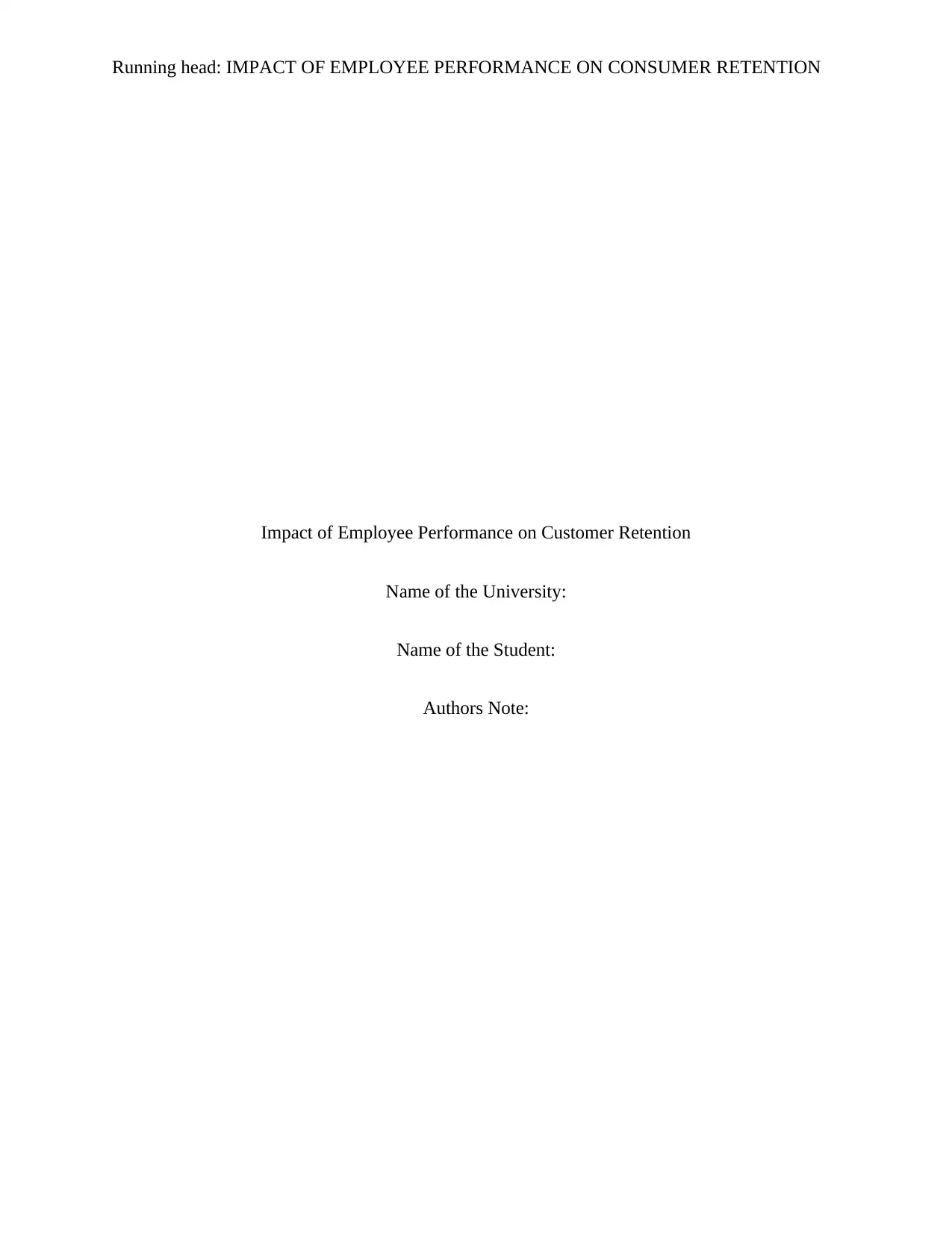
Running head: IMPACT OF EMPLOYEE PERFORMANCE ON CONSUMER RETENTION
Impact of Employee Performance on Customer Retention
Name of the University:
Name of the Student:
Authors Note:
Impact of Employee Performance on Customer Retention
Name of the University:
Name of the Student:
Authors Note:
Paraphrase This Document
Need a fresh take? Get an instant paraphrase of this document with our AI Paraphraser
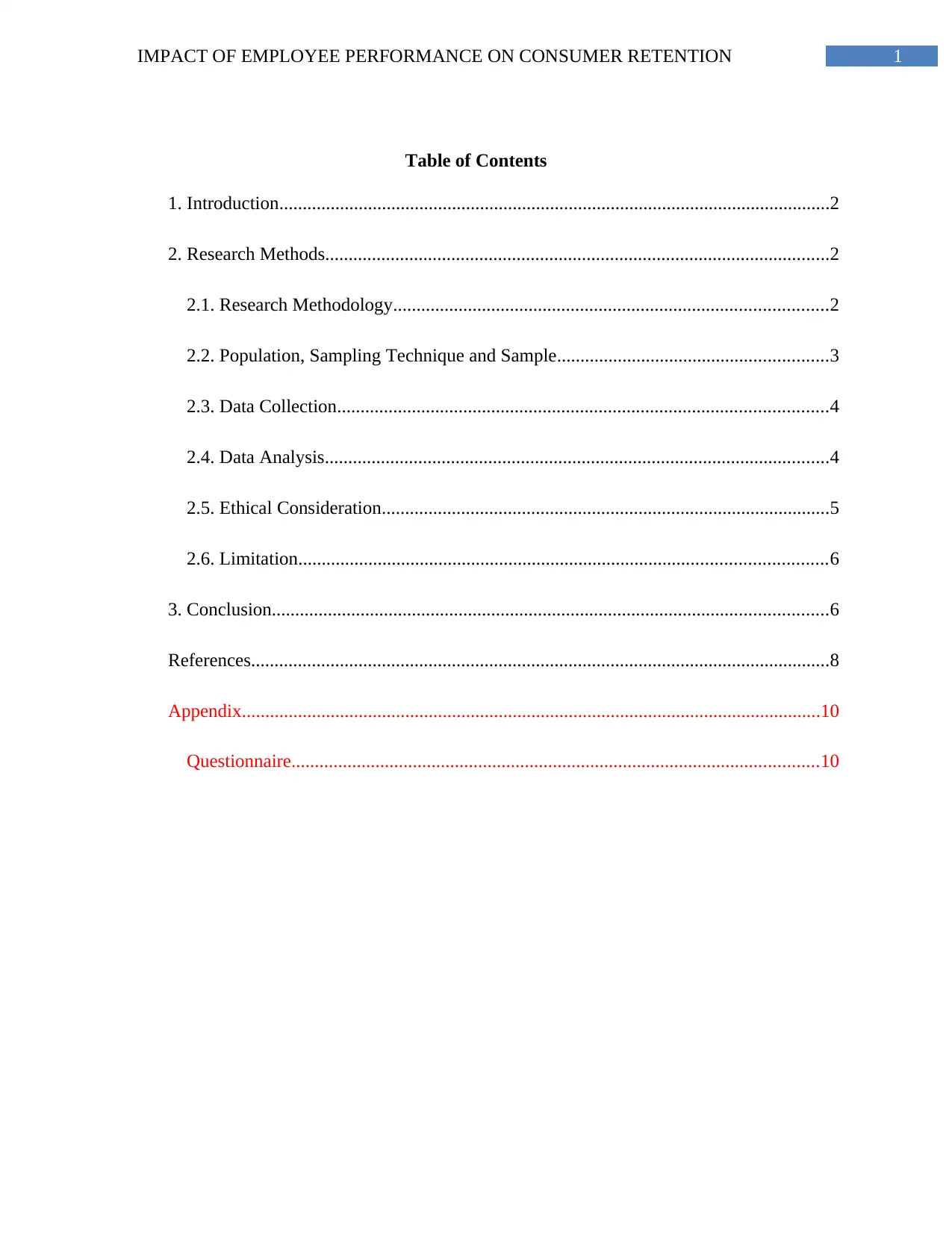
1IMPACT OF EMPLOYEE PERFORMANCE ON CONSUMER RETENTION
Table of Contents
1. Introduction......................................................................................................................2
2. Research Methods............................................................................................................2
2.1. Research Methodology.............................................................................................2
2.2. Population, Sampling Technique and Sample..........................................................3
2.3. Data Collection.........................................................................................................4
2.4. Data Analysis............................................................................................................4
2.5. Ethical Consideration................................................................................................5
2.6. Limitation.................................................................................................................6
3. Conclusion.......................................................................................................................6
References............................................................................................................................8
Appendix............................................................................................................................10
Questionnaire.................................................................................................................10
Table of Contents
1. Introduction......................................................................................................................2
2. Research Methods............................................................................................................2
2.1. Research Methodology.............................................................................................2
2.2. Population, Sampling Technique and Sample..........................................................3
2.3. Data Collection.........................................................................................................4
2.4. Data Analysis............................................................................................................4
2.5. Ethical Consideration................................................................................................5
2.6. Limitation.................................................................................................................6
3. Conclusion.......................................................................................................................6
References............................................................................................................................8
Appendix............................................................................................................................10
Questionnaire.................................................................................................................10
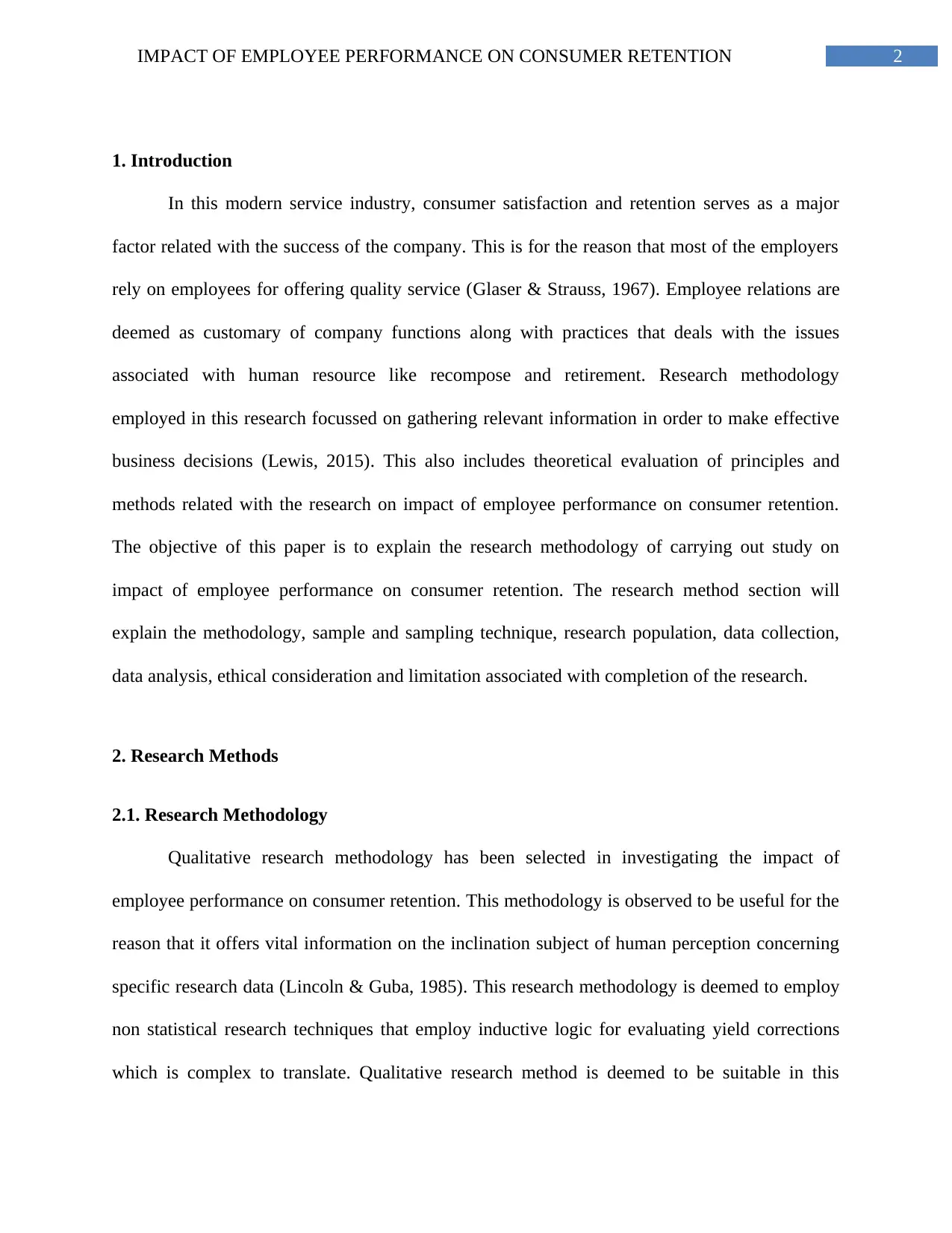
2IMPACT OF EMPLOYEE PERFORMANCE ON CONSUMER RETENTION
1. Introduction
In this modern service industry, consumer satisfaction and retention serves as a major
factor related with the success of the company. This is for the reason that most of the employers
rely on employees for offering quality service (Glaser & Strauss, 1967). Employee relations are
deemed as customary of company functions along with practices that deals with the issues
associated with human resource like recompose and retirement. Research methodology
employed in this research focussed on gathering relevant information in order to make effective
business decisions (Lewis, 2015). This also includes theoretical evaluation of principles and
methods related with the research on impact of employee performance on consumer retention.
The objective of this paper is to explain the research methodology of carrying out study on
impact of employee performance on consumer retention. The research method section will
explain the methodology, sample and sampling technique, research population, data collection,
data analysis, ethical consideration and limitation associated with completion of the research.
2. Research Methods
2.1. Research Methodology
Qualitative research methodology has been selected in investigating the impact of
employee performance on consumer retention. This methodology is observed to be useful for the
reason that it offers vital information on the inclination subject of human perception concerning
specific research data (Lincoln & Guba, 1985). This research methodology is deemed to employ
non statistical research techniques that employ inductive logic for evaluating yield corrections
which is complex to translate. Qualitative research method is deemed to be suitable in this
1. Introduction
In this modern service industry, consumer satisfaction and retention serves as a major
factor related with the success of the company. This is for the reason that most of the employers
rely on employees for offering quality service (Glaser & Strauss, 1967). Employee relations are
deemed as customary of company functions along with practices that deals with the issues
associated with human resource like recompose and retirement. Research methodology
employed in this research focussed on gathering relevant information in order to make effective
business decisions (Lewis, 2015). This also includes theoretical evaluation of principles and
methods related with the research on impact of employee performance on consumer retention.
The objective of this paper is to explain the research methodology of carrying out study on
impact of employee performance on consumer retention. The research method section will
explain the methodology, sample and sampling technique, research population, data collection,
data analysis, ethical consideration and limitation associated with completion of the research.
2. Research Methods
2.1. Research Methodology
Qualitative research methodology has been selected in investigating the impact of
employee performance on consumer retention. This methodology is observed to be useful for the
reason that it offers vital information on the inclination subject of human perception concerning
specific research data (Lincoln & Guba, 1985). This research methodology is deemed to employ
non statistical research techniques that employ inductive logic for evaluating yield corrections
which is complex to translate. Qualitative research method is deemed to be suitable in this
⊘ This is a preview!⊘
Do you want full access?
Subscribe today to unlock all pages.

Trusted by 1+ million students worldwide
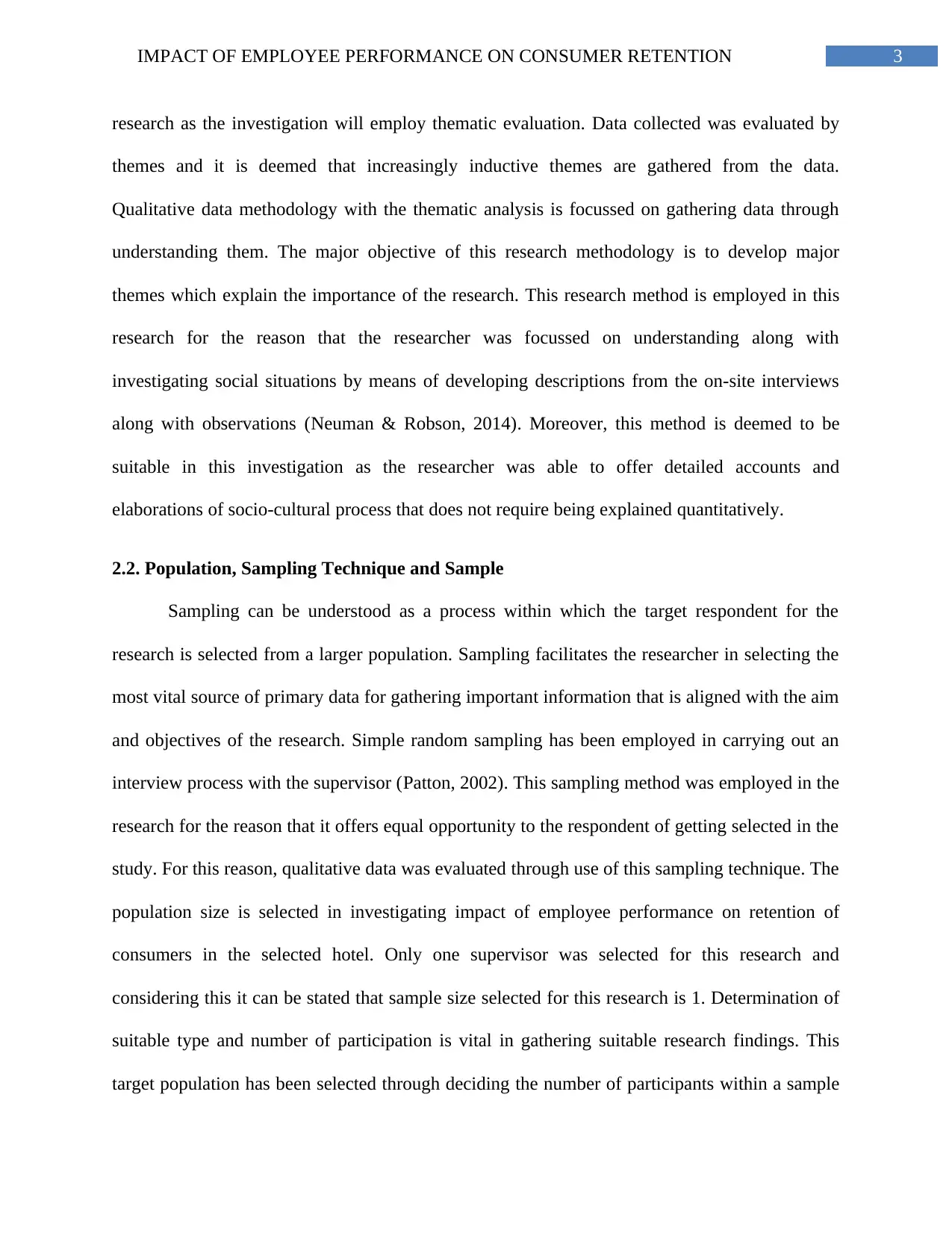
3IMPACT OF EMPLOYEE PERFORMANCE ON CONSUMER RETENTION
research as the investigation will employ thematic evaluation. Data collected was evaluated by
themes and it is deemed that increasingly inductive themes are gathered from the data.
Qualitative data methodology with the thematic analysis is focussed on gathering data through
understanding them. The major objective of this research methodology is to develop major
themes which explain the importance of the research. This research method is employed in this
research for the reason that the researcher was focussed on understanding along with
investigating social situations by means of developing descriptions from the on-site interviews
along with observations (Neuman & Robson, 2014). Moreover, this method is deemed to be
suitable in this investigation as the researcher was able to offer detailed accounts and
elaborations of socio-cultural process that does not require being explained quantitatively.
2.2. Population, Sampling Technique and Sample
Sampling can be understood as a process within which the target respondent for the
research is selected from a larger population. Sampling facilitates the researcher in selecting the
most vital source of primary data for gathering important information that is aligned with the aim
and objectives of the research. Simple random sampling has been employed in carrying out an
interview process with the supervisor (Patton, 2002). This sampling method was employed in the
research for the reason that it offers equal opportunity to the respondent of getting selected in the
study. For this reason, qualitative data was evaluated through use of this sampling technique. The
population size is selected in investigating impact of employee performance on retention of
consumers in the selected hotel. Only one supervisor was selected for this research and
considering this it can be stated that sample size selected for this research is 1. Determination of
suitable type and number of participation is vital in gathering suitable research findings. This
target population has been selected through deciding the number of participants within a sample
research as the investigation will employ thematic evaluation. Data collected was evaluated by
themes and it is deemed that increasingly inductive themes are gathered from the data.
Qualitative data methodology with the thematic analysis is focussed on gathering data through
understanding them. The major objective of this research methodology is to develop major
themes which explain the importance of the research. This research method is employed in this
research for the reason that the researcher was focussed on understanding along with
investigating social situations by means of developing descriptions from the on-site interviews
along with observations (Neuman & Robson, 2014). Moreover, this method is deemed to be
suitable in this investigation as the researcher was able to offer detailed accounts and
elaborations of socio-cultural process that does not require being explained quantitatively.
2.2. Population, Sampling Technique and Sample
Sampling can be understood as a process within which the target respondent for the
research is selected from a larger population. Sampling facilitates the researcher in selecting the
most vital source of primary data for gathering important information that is aligned with the aim
and objectives of the research. Simple random sampling has been employed in carrying out an
interview process with the supervisor (Patton, 2002). This sampling method was employed in the
research for the reason that it offers equal opportunity to the respondent of getting selected in the
study. For this reason, qualitative data was evaluated through use of this sampling technique. The
population size is selected in investigating impact of employee performance on retention of
consumers in the selected hotel. Only one supervisor was selected for this research and
considering this it can be stated that sample size selected for this research is 1. Determination of
suitable type and number of participation is vital in gathering suitable research findings. This
target population has been selected through deciding the number of participants within a sample
Paraphrase This Document
Need a fresh take? Get an instant paraphrase of this document with our AI Paraphraser
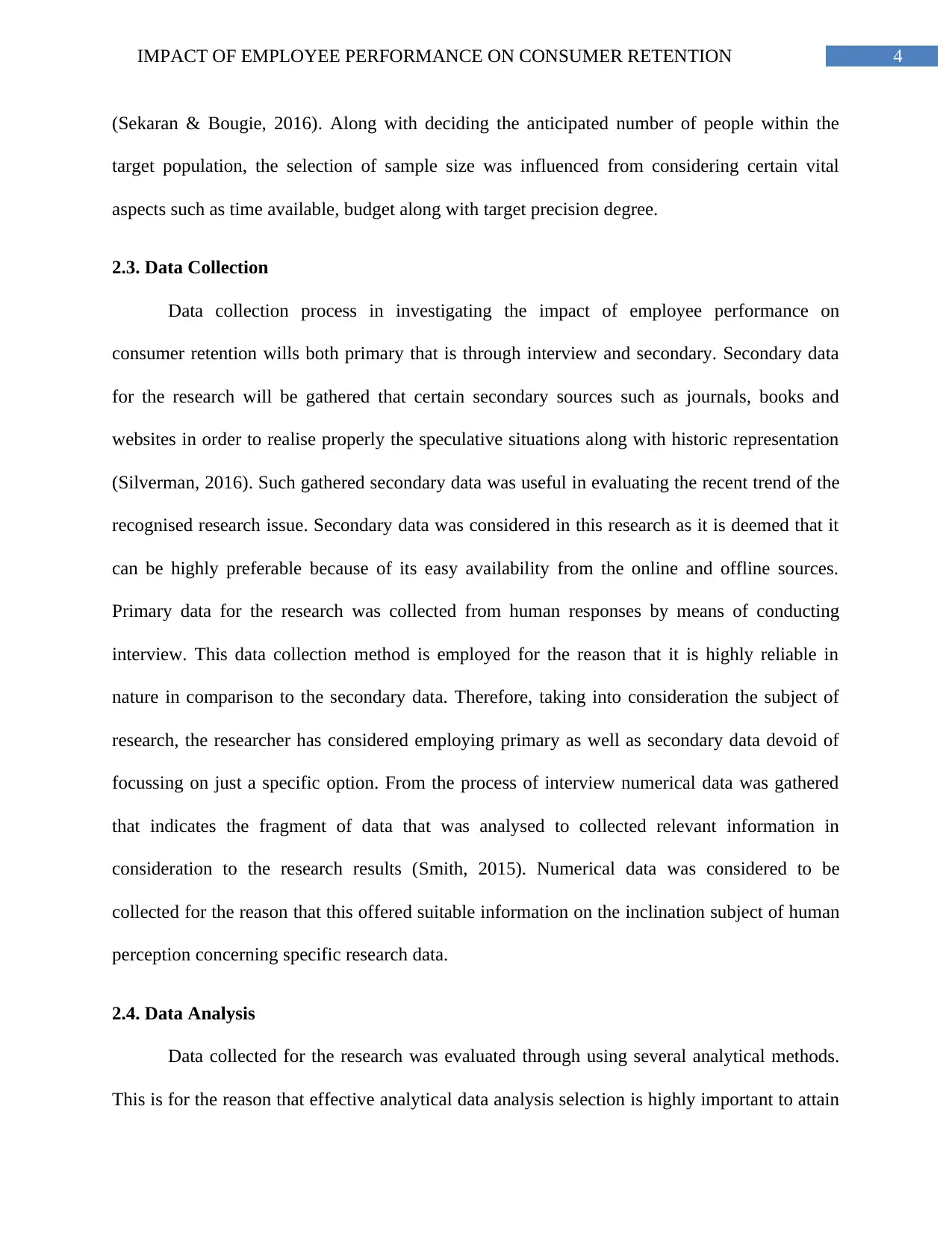
4IMPACT OF EMPLOYEE PERFORMANCE ON CONSUMER RETENTION
(Sekaran & Bougie, 2016). Along with deciding the anticipated number of people within the
target population, the selection of sample size was influenced from considering certain vital
aspects such as time available, budget along with target precision degree.
2.3. Data Collection
Data collection process in investigating the impact of employee performance on
consumer retention wills both primary that is through interview and secondary. Secondary data
for the research will be gathered that certain secondary sources such as journals, books and
websites in order to realise properly the speculative situations along with historic representation
(Silverman, 2016). Such gathered secondary data was useful in evaluating the recent trend of the
recognised research issue. Secondary data was considered in this research as it is deemed that it
can be highly preferable because of its easy availability from the online and offline sources.
Primary data for the research was collected from human responses by means of conducting
interview. This data collection method is employed for the reason that it is highly reliable in
nature in comparison to the secondary data. Therefore, taking into consideration the subject of
research, the researcher has considered employing primary as well as secondary data devoid of
focussing on just a specific option. From the process of interview numerical data was gathered
that indicates the fragment of data that was analysed to collected relevant information in
consideration to the research results (Smith, 2015). Numerical data was considered to be
collected for the reason that this offered suitable information on the inclination subject of human
perception concerning specific research data.
2.4. Data Analysis
Data collected for the research was evaluated through using several analytical methods.
This is for the reason that effective analytical data analysis selection is highly important to attain
(Sekaran & Bougie, 2016). Along with deciding the anticipated number of people within the
target population, the selection of sample size was influenced from considering certain vital
aspects such as time available, budget along with target precision degree.
2.3. Data Collection
Data collection process in investigating the impact of employee performance on
consumer retention wills both primary that is through interview and secondary. Secondary data
for the research will be gathered that certain secondary sources such as journals, books and
websites in order to realise properly the speculative situations along with historic representation
(Silverman, 2016). Such gathered secondary data was useful in evaluating the recent trend of the
recognised research issue. Secondary data was considered in this research as it is deemed that it
can be highly preferable because of its easy availability from the online and offline sources.
Primary data for the research was collected from human responses by means of conducting
interview. This data collection method is employed for the reason that it is highly reliable in
nature in comparison to the secondary data. Therefore, taking into consideration the subject of
research, the researcher has considered employing primary as well as secondary data devoid of
focussing on just a specific option. From the process of interview numerical data was gathered
that indicates the fragment of data that was analysed to collected relevant information in
consideration to the research results (Smith, 2015). Numerical data was considered to be
collected for the reason that this offered suitable information on the inclination subject of human
perception concerning specific research data.
2.4. Data Analysis
Data collected for the research was evaluated through using several analytical methods.
This is for the reason that effective analytical data analysis selection is highly important to attain
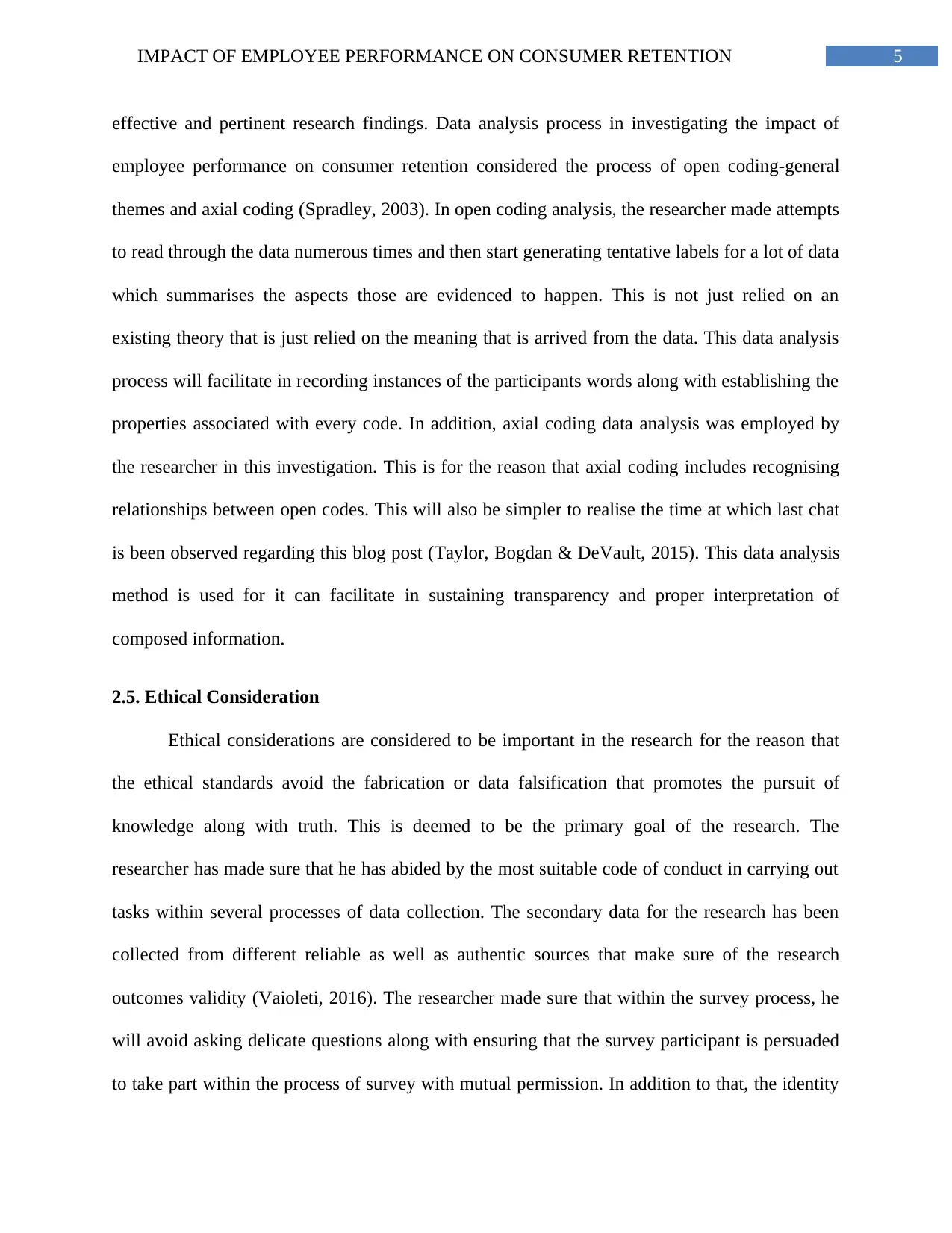
5IMPACT OF EMPLOYEE PERFORMANCE ON CONSUMER RETENTION
effective and pertinent research findings. Data analysis process in investigating the impact of
employee performance on consumer retention considered the process of open coding-general
themes and axial coding (Spradley, 2003). In open coding analysis, the researcher made attempts
to read through the data numerous times and then start generating tentative labels for a lot of data
which summarises the aspects those are evidenced to happen. This is not just relied on an
existing theory that is just relied on the meaning that is arrived from the data. This data analysis
process will facilitate in recording instances of the participants words along with establishing the
properties associated with every code. In addition, axial coding data analysis was employed by
the researcher in this investigation. This is for the reason that axial coding includes recognising
relationships between open codes. This will also be simpler to realise the time at which last chat
is been observed regarding this blog post (Taylor, Bogdan & DeVault, 2015). This data analysis
method is used for it can facilitate in sustaining transparency and proper interpretation of
composed information.
2.5. Ethical Consideration
Ethical considerations are considered to be important in the research for the reason that
the ethical standards avoid the fabrication or data falsification that promotes the pursuit of
knowledge along with truth. This is deemed to be the primary goal of the research. The
researcher has made sure that he has abided by the most suitable code of conduct in carrying out
tasks within several processes of data collection. The secondary data for the research has been
collected from different reliable as well as authentic sources that make sure of the research
outcomes validity (Vaioleti, 2016). The researcher made sure that within the survey process, he
will avoid asking delicate questions along with ensuring that the survey participant is persuaded
to take part within the process of survey with mutual permission. In addition to that, the identity
effective and pertinent research findings. Data analysis process in investigating the impact of
employee performance on consumer retention considered the process of open coding-general
themes and axial coding (Spradley, 2003). In open coding analysis, the researcher made attempts
to read through the data numerous times and then start generating tentative labels for a lot of data
which summarises the aspects those are evidenced to happen. This is not just relied on an
existing theory that is just relied on the meaning that is arrived from the data. This data analysis
process will facilitate in recording instances of the participants words along with establishing the
properties associated with every code. In addition, axial coding data analysis was employed by
the researcher in this investigation. This is for the reason that axial coding includes recognising
relationships between open codes. This will also be simpler to realise the time at which last chat
is been observed regarding this blog post (Taylor, Bogdan & DeVault, 2015). This data analysis
method is used for it can facilitate in sustaining transparency and proper interpretation of
composed information.
2.5. Ethical Consideration
Ethical considerations are considered to be important in the research for the reason that
the ethical standards avoid the fabrication or data falsification that promotes the pursuit of
knowledge along with truth. This is deemed to be the primary goal of the research. The
researcher has made sure that he has abided by the most suitable code of conduct in carrying out
tasks within several processes of data collection. The secondary data for the research has been
collected from different reliable as well as authentic sources that make sure of the research
outcomes validity (Vaioleti, 2016). The researcher made sure that within the survey process, he
will avoid asking delicate questions along with ensuring that the survey participant is persuaded
to take part within the process of survey with mutual permission. In addition to that, the identity
⊘ This is a preview!⊘
Do you want full access?
Subscribe today to unlock all pages.

Trusted by 1+ million students worldwide
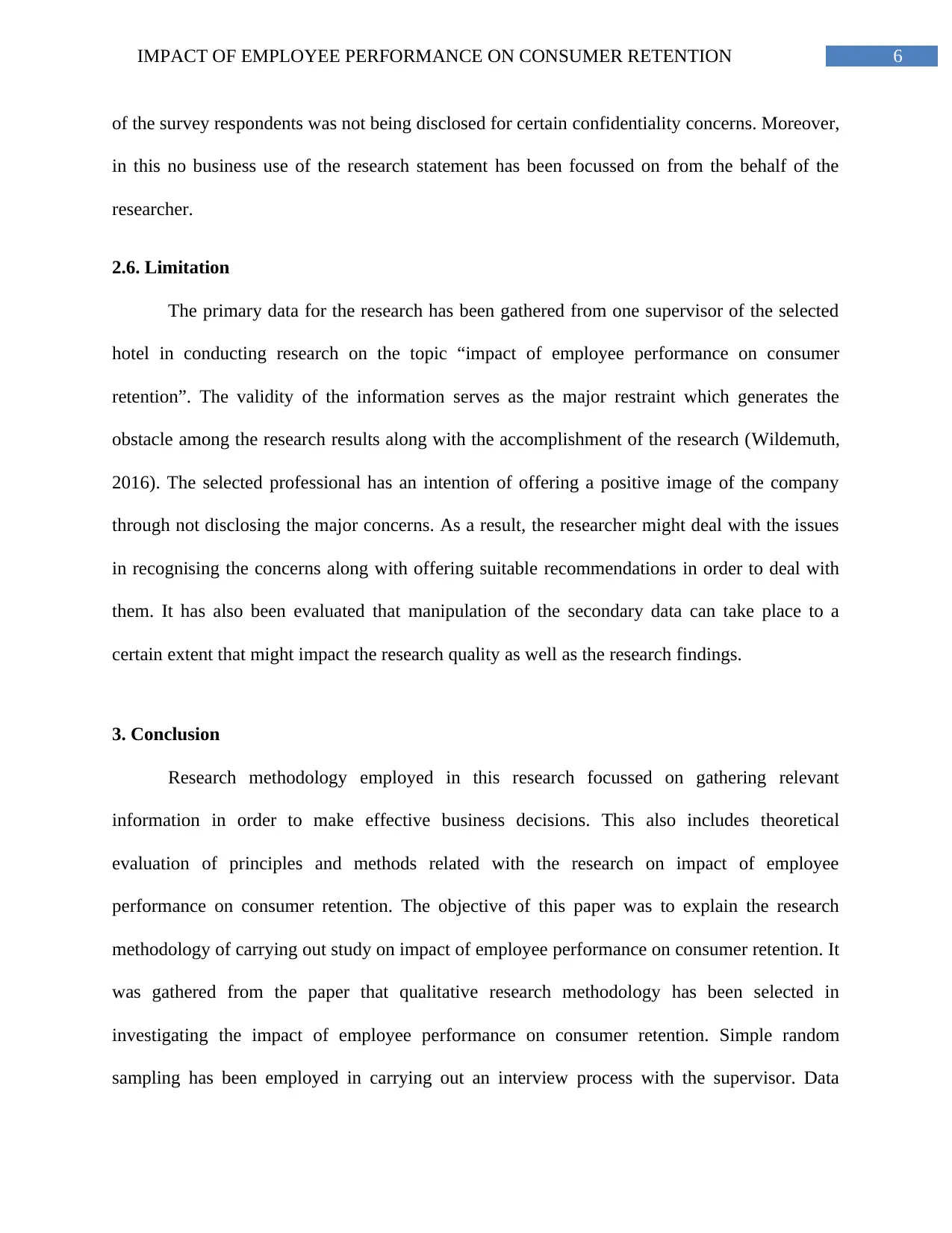
6IMPACT OF EMPLOYEE PERFORMANCE ON CONSUMER RETENTION
of the survey respondents was not being disclosed for certain confidentiality concerns. Moreover,
in this no business use of the research statement has been focussed on from the behalf of the
researcher.
2.6. Limitation
The primary data for the research has been gathered from one supervisor of the selected
hotel in conducting research on the topic “impact of employee performance on consumer
retention”. The validity of the information serves as the major restraint which generates the
obstacle among the research results along with the accomplishment of the research (Wildemuth,
2016). The selected professional has an intention of offering a positive image of the company
through not disclosing the major concerns. As a result, the researcher might deal with the issues
in recognising the concerns along with offering suitable recommendations in order to deal with
them. It has also been evaluated that manipulation of the secondary data can take place to a
certain extent that might impact the research quality as well as the research findings.
3. Conclusion
Research methodology employed in this research focussed on gathering relevant
information in order to make effective business decisions. This also includes theoretical
evaluation of principles and methods related with the research on impact of employee
performance on consumer retention. The objective of this paper was to explain the research
methodology of carrying out study on impact of employee performance on consumer retention. It
was gathered from the paper that qualitative research methodology has been selected in
investigating the impact of employee performance on consumer retention. Simple random
sampling has been employed in carrying out an interview process with the supervisor. Data
of the survey respondents was not being disclosed for certain confidentiality concerns. Moreover,
in this no business use of the research statement has been focussed on from the behalf of the
researcher.
2.6. Limitation
The primary data for the research has been gathered from one supervisor of the selected
hotel in conducting research on the topic “impact of employee performance on consumer
retention”. The validity of the information serves as the major restraint which generates the
obstacle among the research results along with the accomplishment of the research (Wildemuth,
2016). The selected professional has an intention of offering a positive image of the company
through not disclosing the major concerns. As a result, the researcher might deal with the issues
in recognising the concerns along with offering suitable recommendations in order to deal with
them. It has also been evaluated that manipulation of the secondary data can take place to a
certain extent that might impact the research quality as well as the research findings.
3. Conclusion
Research methodology employed in this research focussed on gathering relevant
information in order to make effective business decisions. This also includes theoretical
evaluation of principles and methods related with the research on impact of employee
performance on consumer retention. The objective of this paper was to explain the research
methodology of carrying out study on impact of employee performance on consumer retention. It
was gathered from the paper that qualitative research methodology has been selected in
investigating the impact of employee performance on consumer retention. Simple random
sampling has been employed in carrying out an interview process with the supervisor. Data
Paraphrase This Document
Need a fresh take? Get an instant paraphrase of this document with our AI Paraphraser
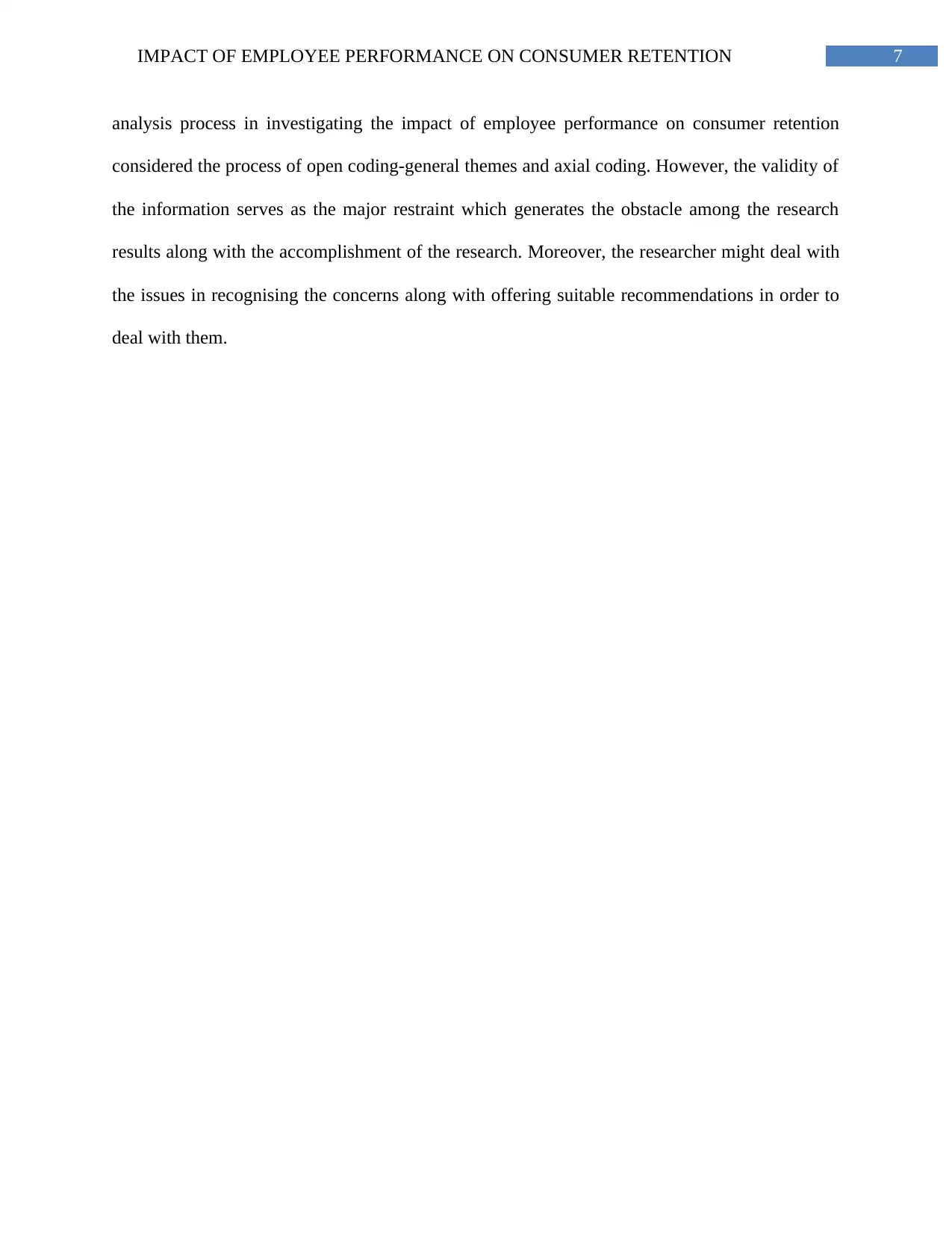
7IMPACT OF EMPLOYEE PERFORMANCE ON CONSUMER RETENTION
analysis process in investigating the impact of employee performance on consumer retention
considered the process of open coding-general themes and axial coding. However, the validity of
the information serves as the major restraint which generates the obstacle among the research
results along with the accomplishment of the research. Moreover, the researcher might deal with
the issues in recognising the concerns along with offering suitable recommendations in order to
deal with them.
analysis process in investigating the impact of employee performance on consumer retention
considered the process of open coding-general themes and axial coding. However, the validity of
the information serves as the major restraint which generates the obstacle among the research
results along with the accomplishment of the research. Moreover, the researcher might deal with
the issues in recognising the concerns along with offering suitable recommendations in order to
deal with them.
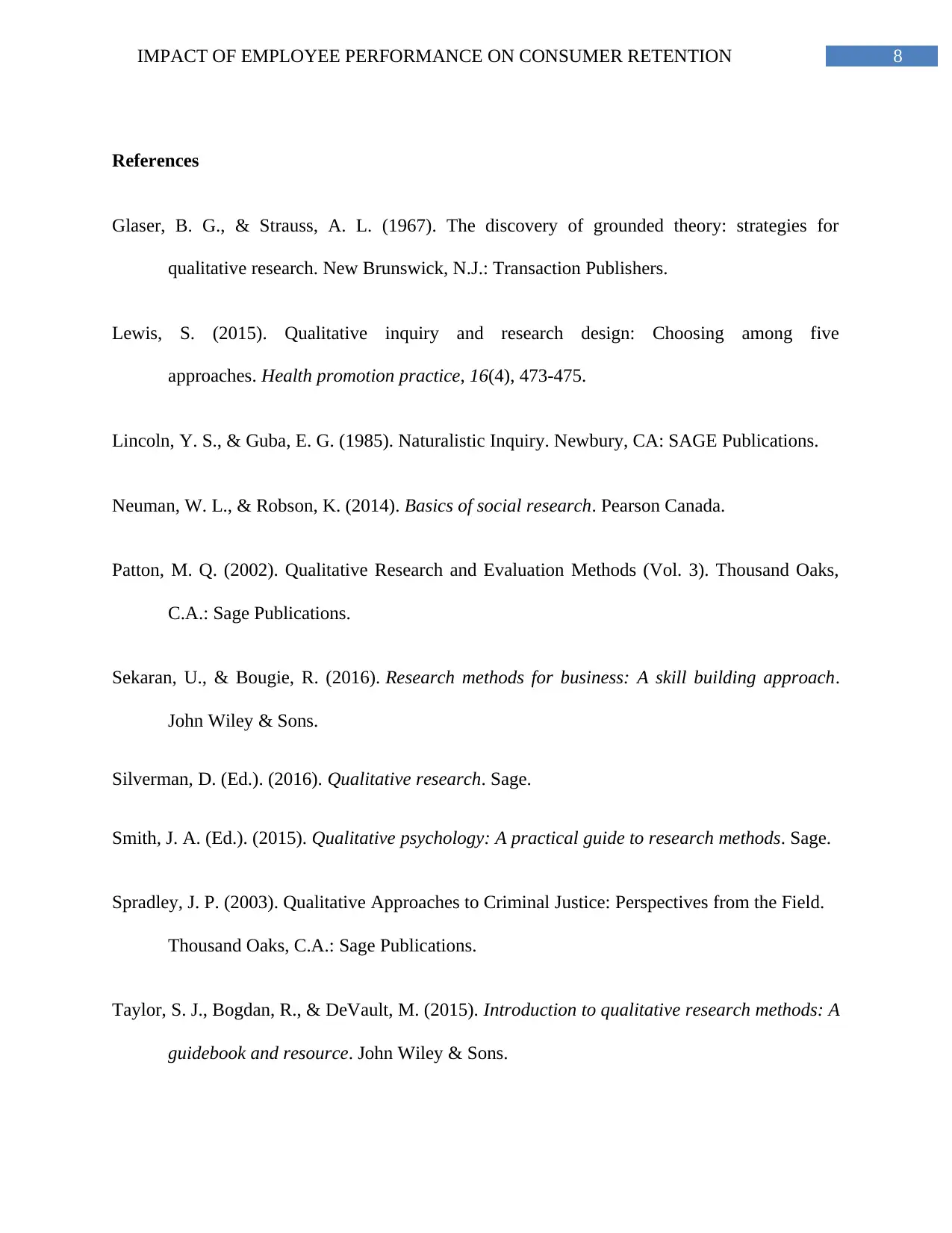
8IMPACT OF EMPLOYEE PERFORMANCE ON CONSUMER RETENTION
References
Glaser, B. G., & Strauss, A. L. (1967). The discovery of grounded theory: strategies for
qualitative research. New Brunswick, N.J.: Transaction Publishers.
Lewis, S. (2015). Qualitative inquiry and research design: Choosing among five
approaches. Health promotion practice, 16(4), 473-475.
Lincoln, Y. S., & Guba, E. G. (1985). Naturalistic Inquiry. Newbury, CA: SAGE Publications.
Neuman, W. L., & Robson, K. (2014). Basics of social research. Pearson Canada.
Patton, M. Q. (2002). Qualitative Research and Evaluation Methods (Vol. 3). Thousand Oaks,
C.A.: Sage Publications.
Sekaran, U., & Bougie, R. (2016). Research methods for business: A skill building approach.
John Wiley & Sons.
Silverman, D. (Ed.). (2016). Qualitative research. Sage.
Smith, J. A. (Ed.). (2015). Qualitative psychology: A practical guide to research methods. Sage.
Spradley, J. P. (2003). Qualitative Approaches to Criminal Justice: Perspectives from the Field.
Thousand Oaks, C.A.: Sage Publications.
Taylor, S. J., Bogdan, R., & DeVault, M. (2015). Introduction to qualitative research methods: A
guidebook and resource. John Wiley & Sons.
References
Glaser, B. G., & Strauss, A. L. (1967). The discovery of grounded theory: strategies for
qualitative research. New Brunswick, N.J.: Transaction Publishers.
Lewis, S. (2015). Qualitative inquiry and research design: Choosing among five
approaches. Health promotion practice, 16(4), 473-475.
Lincoln, Y. S., & Guba, E. G. (1985). Naturalistic Inquiry. Newbury, CA: SAGE Publications.
Neuman, W. L., & Robson, K. (2014). Basics of social research. Pearson Canada.
Patton, M. Q. (2002). Qualitative Research and Evaluation Methods (Vol. 3). Thousand Oaks,
C.A.: Sage Publications.
Sekaran, U., & Bougie, R. (2016). Research methods for business: A skill building approach.
John Wiley & Sons.
Silverman, D. (Ed.). (2016). Qualitative research. Sage.
Smith, J. A. (Ed.). (2015). Qualitative psychology: A practical guide to research methods. Sage.
Spradley, J. P. (2003). Qualitative Approaches to Criminal Justice: Perspectives from the Field.
Thousand Oaks, C.A.: Sage Publications.
Taylor, S. J., Bogdan, R., & DeVault, M. (2015). Introduction to qualitative research methods: A
guidebook and resource. John Wiley & Sons.
⊘ This is a preview!⊘
Do you want full access?
Subscribe today to unlock all pages.

Trusted by 1+ million students worldwide

9IMPACT OF EMPLOYEE PERFORMANCE ON CONSUMER RETENTION
Vaioleti, T. M. (2016). Talanoa research methodology: A developing position on Pacific
research. Waikato Journal of Education, 12(1).
Wildemuth, B. M. (Ed.). (2016). Applications of social research methods to questions in
information and library science. ABC-CLIO.
Vaioleti, T. M. (2016). Talanoa research methodology: A developing position on Pacific
research. Waikato Journal of Education, 12(1).
Wildemuth, B. M. (Ed.). (2016). Applications of social research methods to questions in
information and library science. ABC-CLIO.
Paraphrase This Document
Need a fresh take? Get an instant paraphrase of this document with our AI Paraphraser
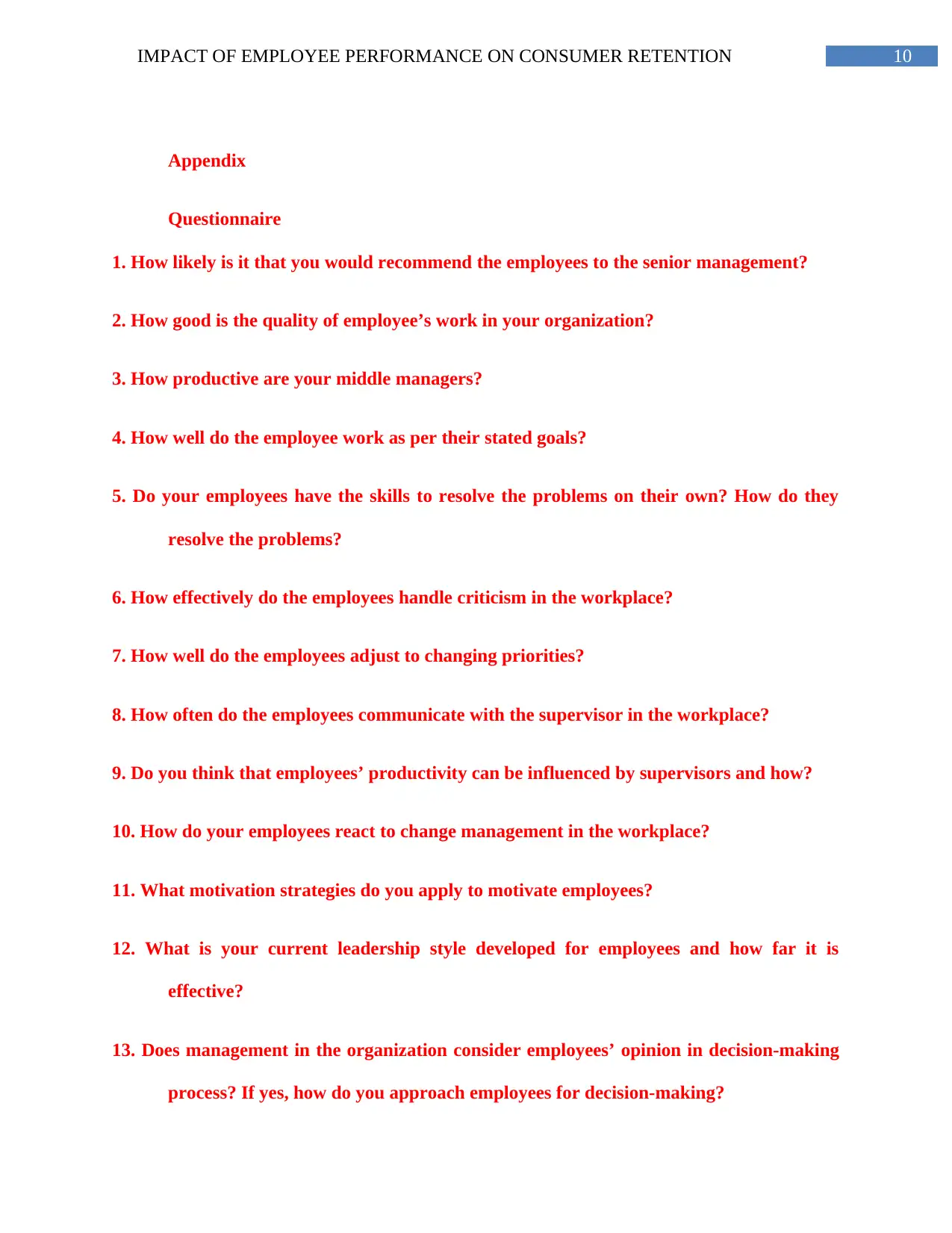
10IMPACT OF EMPLOYEE PERFORMANCE ON CONSUMER RETENTION
Appendix
Questionnaire
1. How likely is it that you would recommend the employees to the senior management?
2. How good is the quality of employee’s work in your organization?
3. How productive are your middle managers?
4. How well do the employee work as per their stated goals?
5. Do your employees have the skills to resolve the problems on their own? How do they
resolve the problems?
6. How effectively do the employees handle criticism in the workplace?
7. How well do the employees adjust to changing priorities?
8. How often do the employees communicate with the supervisor in the workplace?
9. Do you think that employees’ productivity can be influenced by supervisors and how?
10. How do your employees react to change management in the workplace?
11. What motivation strategies do you apply to motivate employees?
12. What is your current leadership style developed for employees and how far it is
effective?
13. Does management in the organization consider employees’ opinion in decision-making
process? If yes, how do you approach employees for decision-making?
Appendix
Questionnaire
1. How likely is it that you would recommend the employees to the senior management?
2. How good is the quality of employee’s work in your organization?
3. How productive are your middle managers?
4. How well do the employee work as per their stated goals?
5. Do your employees have the skills to resolve the problems on their own? How do they
resolve the problems?
6. How effectively do the employees handle criticism in the workplace?
7. How well do the employees adjust to changing priorities?
8. How often do the employees communicate with the supervisor in the workplace?
9. Do you think that employees’ productivity can be influenced by supervisors and how?
10. How do your employees react to change management in the workplace?
11. What motivation strategies do you apply to motivate employees?
12. What is your current leadership style developed for employees and how far it is
effective?
13. Does management in the organization consider employees’ opinion in decision-making
process? If yes, how do you approach employees for decision-making?
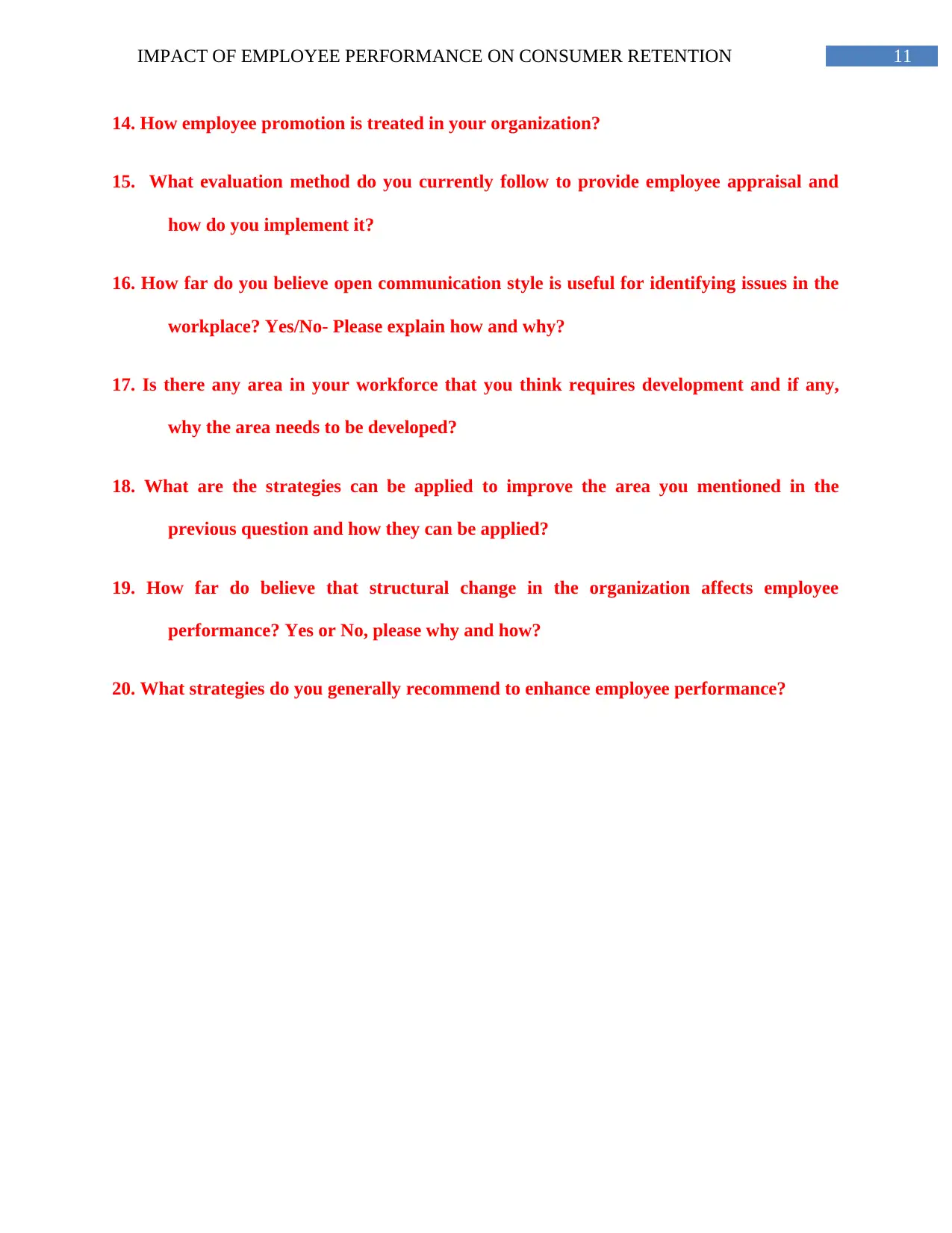
11IMPACT OF EMPLOYEE PERFORMANCE ON CONSUMER RETENTION
14. How employee promotion is treated in your organization?
15. What evaluation method do you currently follow to provide employee appraisal and
how do you implement it?
16. How far do you believe open communication style is useful for identifying issues in the
workplace? Yes/No- Please explain how and why?
17. Is there any area in your workforce that you think requires development and if any,
why the area needs to be developed?
18. What are the strategies can be applied to improve the area you mentioned in the
previous question and how they can be applied?
19. How far do believe that structural change in the organization affects employee
performance? Yes or No, please why and how?
20. What strategies do you generally recommend to enhance employee performance?
14. How employee promotion is treated in your organization?
15. What evaluation method do you currently follow to provide employee appraisal and
how do you implement it?
16. How far do you believe open communication style is useful for identifying issues in the
workplace? Yes/No- Please explain how and why?
17. Is there any area in your workforce that you think requires development and if any,
why the area needs to be developed?
18. What are the strategies can be applied to improve the area you mentioned in the
previous question and how they can be applied?
19. How far do believe that structural change in the organization affects employee
performance? Yes or No, please why and how?
20. What strategies do you generally recommend to enhance employee performance?
⊘ This is a preview!⊘
Do you want full access?
Subscribe today to unlock all pages.

Trusted by 1+ million students worldwide
1 out of 12
Related Documents
Your All-in-One AI-Powered Toolkit for Academic Success.
+13062052269
info@desklib.com
Available 24*7 on WhatsApp / Email
![[object Object]](/_next/static/media/star-bottom.7253800d.svg)
Unlock your academic potential
Copyright © 2020–2025 A2Z Services. All Rights Reserved. Developed and managed by ZUCOL.





